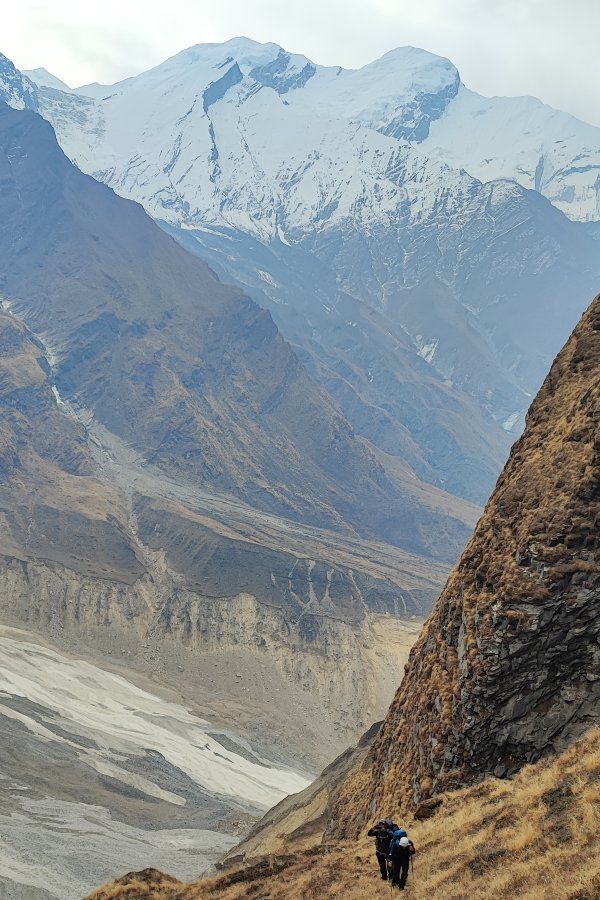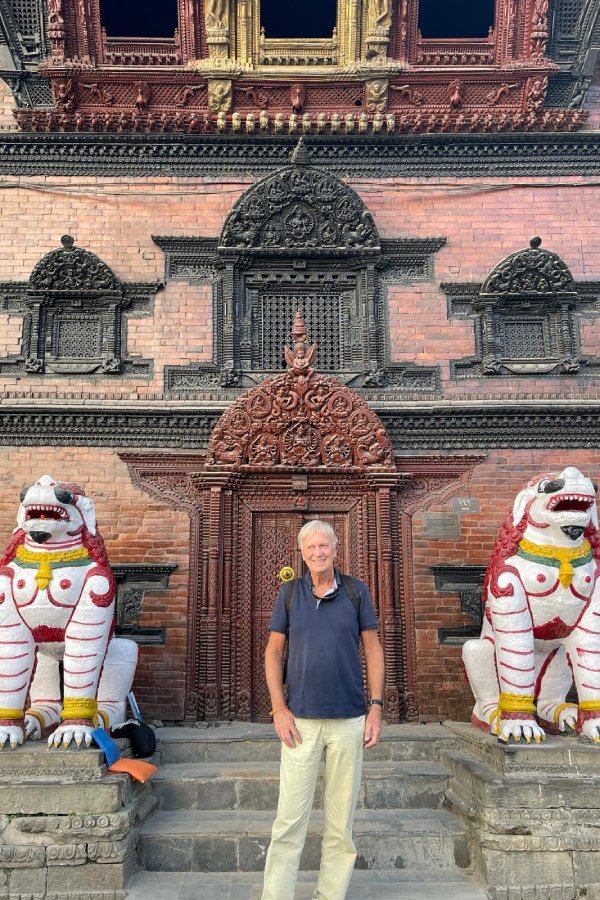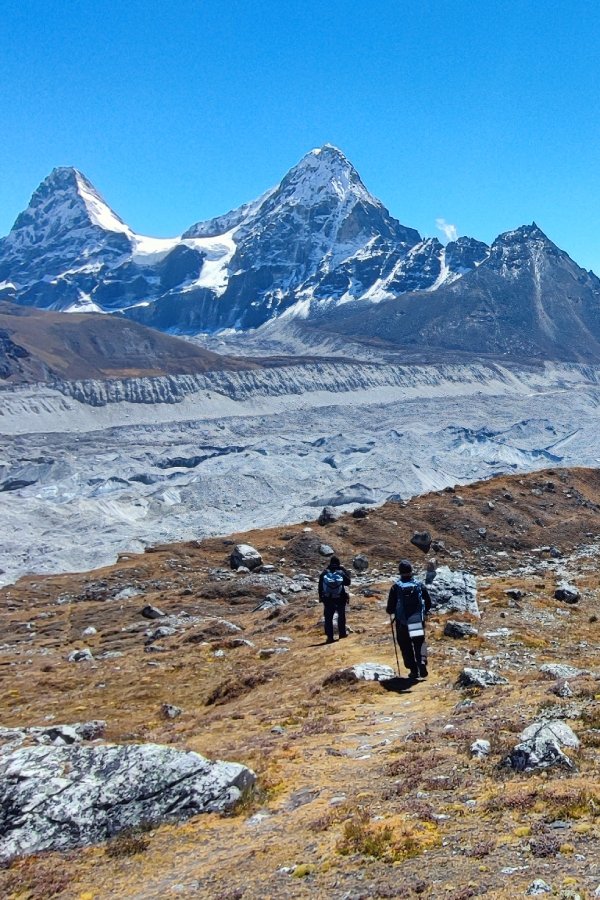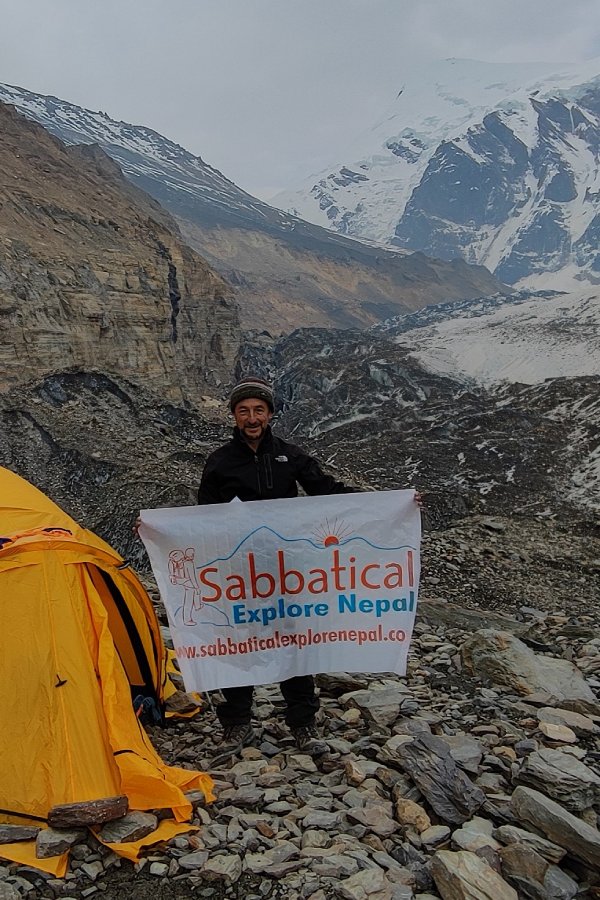Geographically, Nepal is a landlocked country in South Asia, between two giant neighbors--India and China. 'The country of Mt Everest, 'The Birthplace of Gautam Buddha', many often use those phrases to introduce Nepal, but there are many more.Nepal has lush green hills and mountains that trekkers appreciate, the highest of the mountains in the world for climbers, an abundance of flora and fauna, unique and diverse cultures, ancient art and architecture, and a lot much more.
Languages in Nepal
Nepal, there are currently 123 different languages spoken in the country. Of them, Nepali is the common language that is spoken and understood by the majority of the population in the country.
In Kathmandu Valley, you may hear the Newari language spoken by the indigenous of the valley. People in urban and major trekking regions understand English. But in rural and non-touristy places, it might be difficult for you since the people there do not understand English. So, it will be an advantage for you to understand a little bit of Nepali.Here are a few major Nepali words and sentences with their English equivalents:"Namaste-- Hello".
"Dhanyabaad-- Thank you".
"Tapailai kasto chha?-- How are you?"
"Malai euta sahayog garna saknu hunchha?-- Could you please help me?"
"Tapai ko naam k ho?-- What is your name?"
"Mero naam … ho-- My name is ..."
"Eslai kati parchha?-- How much does it cost?"
Currency in Nepal
The Nepalese rupee (NPR) is the currency of usage in Nepal. One US Dollar is approximately equal to 114 NPR.You can exchange various currencies (including the currency of your country) with Nepali currency at the Tribhuvan International Airport and various other locations in Kathmandu. You can also withdraw Nepali currency from ATMs of Nepali banks across the country bearing a charge of NPR 500 per transaction.
Legal requirements to Enter Nepal
A Nepali visa is the only legal requirement to enter Nepal. Getting a Nepali visa is not as difficult as that for many tourist destinations around the globe. You can acquire a Nepali visa on arrival at the Tribhuvan International Airport, Kathmandu. You will need to fill out an application form for that.The rate of a Nepali tourist visa is determined by the duration of your stay in the country. For a stay of 15 days, you will have to pay US $ 30. Similarly, for 30 days, you will have to pay US $ 50. And, for a stay of 90 days, you will have to pay US $ 125.
Food in Nepal
People from different cultural backgrounds and geographical regions enjoy different varieties of food. 'Daal' (lentil) and 'Bhaat' (rice) is an everyday food throughout the country and is combined with various other items such as 'Gundruk ko Achaar' (a special pickle) in the hilly region.Dhido--a cooked dish made from flour of various grains like Maize, Wheat, among others--is the signature cuisine of Nepal. It is usually served with a special spinach known as Sisnu or with various pickles. It is common in rural places, but you can find it in restaurants in urban places like Kathmandu as well.
Among other popular Nepali cuisines is The Thakali Set--named after the Thakali people of Himalaya.
The Thakali Khana Set consists of boiled rice, daal (lentil), leafy vegetables, pickles, and meat (if you are a non-veg).
Similarly, there is Thakali Khaja Set as well which consists of Chiura (beaten rice) instead of boiled rice and also includes vegetables and pickles. You can also try various Newari dishes like Choila and Bara in Kathmandu valley.
Mo: Mo is a popular dish among the youth. It is a dumpling made of flour that is filled with vegetables or meat (chicken, mutton, or buffalo) and served with soup or pickles. You can find Mo: Mo in almost any restaurant in urban centers like Kathmandu, but it is not much popular in the rural corners of Nepal.
Accommodation in Nepal
You will find accommodation of your choice in Nepal. Accommodation facilities in Nepal range from expensive five-star hotels to affordable guesthouses. These days Bed and Breakfast (BnB) services are also available in various places across the country.Hotels and guesthouses are rare in the rural places of Nepal. The Homestay Project launched by the government and local people provides affordable and homely accommodation in various rural places.
You need not worry if you do not find any such place during your journey in Nepal. Nepali people believe in 'Atithi Devo Bhava' which means 'guests are gods'. So, if you are in trouble finding any hotel or guesthouse, you can simply ask people to host you for a day. A Nepali would rarely turn his back when someone is in need of help.
We advise you to carry sleeping bags and tents if you are traveling to high-altitude remote areas. This is because the climate there is too cold and those places have thin settlements making it difficult for you to find a house or a hotel.
Transportation in Nepal
Roadways and airways are major modes of transportation in Nepal. Water transport has not flourished since Nepal is a landlocked country. Similarly, Nepal has no railway as well. However, the government is currently undertaking some waterway and railway projects which are deemed to be completed soon.The road is the most common way to travel from one place to another in Nepal. Bus services are available which can take you from one place to another. Buses are generally of two types: 'Local bus' and 'Tourist bus'. You can opt for a comparatively luxurious journey on the 'Tourist bus', but the 'Local bus' can provide you with the real experience of Nepal, like the one every backpacker seeks. You can travel via local buses interacting with Nepalis from various walks of life. It is important to tell you that local buses in Nepal are often crowded. You may opt for a tourist bus if you want a more personal tour.
Not every place in Nepal is linked by roads. In such a case, the airway can be of great assistance to you. Various domestic flights can take you to major parts of the country. Flights can be helpful when you want to explore most of Nepal in the least time. Winding roads in Nepal are considered to be risky by many people. In that case, as well, airplane flights can be of great assistance. There are customized airplane flights as well which provide you with an experience of important tourist places. One such flight is Mountain Flight to the Everest region. You can also take a helicopter tour to the place of your choice.
What activities can you do?
There are a range of activities that you can pursue in Nepal. The type of activities offered is highly affected by weather and landscapes. Here we have picked a few activities that might interest you:
Trekking:
Trekking is the most popular activity among backpackers in Nepal. That is because Nepal has varying landscapes that sometimes take people downhill and some other times uphill, providing them the real experience of trekking.
With the varying landscapes throughout, there are a number of treks you can undertake. Among them, Everest Base Camp Trek (12 days), Annapurna Base Camp Trek (10 days), and Annapurna Circuit Trek (23 days) are the most popular ones.
Rafting:
Nepal has fast-flowing rivers like Trishuli and Bhote Koshi which makes rafting in these rivers possible. If you are an adventure seeker, you may want to join rafting at one of these rivers.
Bungee Jumping:
Bungee jumping is also for thrill seekers. Bungee jumping at Bhote Koshi will make you fall 160 meters from the suspension bridge. Meanwhile, bungee jumping from a tower at Pokhara will take you as below 80 meters. You may choose among them depending on your ability to endure and your personal choice.
Paragliding:
Have you ever imagined flying over the mountains and lakes? That is exactly what paragliding at Pokhara provides you. You will fly from the top of a mountain known as Sarangkot and will land at the bank of Fewa lake after about 30 minutes. You can also have a longer duration of paragliding (about an hour) if you want to. You can enjoy the fantastic views of mountains like Annapurna, Machhapuchhre, and Dhaulagiri along with an aerial view of Fewa, Rupa, and Begnas lake.
Mountain Expedition:
Known as the Land of Himalayas, Nepal is perfect for mountaineering. Nepal has 8 of the world's 10 highest peaks, namely Everest, Kanchenjunga, Lhotse, Makalu, Cho Oyu, Dhaulagiri, Manaslu, and Annapurna.
You will need to have enough training and equipment in order to climb these mountains. You can also opt to climb other small mountains in Nepal.
Jungle Safari:
If you are interested in exploring the flora and fauna of Nepal, you can take a safari by riding an elephant or via jeep. Chitwan National Park, Banke National Park, Bardia National Park, and Koshi Tappu Wildlife Reserve are popular for taking a safari.
Which places should you visit?
Nepal is rich in terms of places that deserve a visit. However, we have handpicked a few places that you would not want to miss during your visit to Nepal. Here they are:
Kathmandu Valley:
Kathmandu is the capital of Nepal. Kathmandu valley comprises three districts, namely Kathmandu, Bhaktapur, and Lalitpur. Within the dense settlements of the valley, you will find a lot to explore.  The ancient and medieval art and architecture will leave you surprised. Pagoda-style temples and dome-shaped stupas are also major attractions. You can spend your time visiting the cultural heritage of Kathmandu listed by UNESCO on the World Heritage List.
In the list, the three are the palace (durbar) squares, namely Basantapur Durbar Square (in Kathmandu), Patan Durbar Square (in Lalitpur), and Bhaktapur Durbar Square (in Bhaktapur). Two are Buddhist shrines, namely Baudhanth and Swayambhunath. The other two are Hindu temples, namely Pashupatinath--the temple of Lord Shiva, and Changunarayan--the temple of Lord Vishnu.
You can enjoy Newari foods while you are in Kathmandu valley. One can also choose to take short hikes around Kathmandu valley, like the Sundarijal-Chisapani-Nagarkot hike which can be completed in just two days.
Pokhara:
Pokhara is also known as the city of lakes. Fewa, Rupa, and Begnas are among the signature lakes of this city.
Situated at the foot of the Annapurna mountain range, this city has a lot to offer to backpackers. That is because of the diversity of activities that are viable in and around Pokhara. You can head towards the Annapurna region from Pokhara for trekking. Bungee jumping and paragliding are also feasible in Pokhara alongside boating at the famous lakes.Calm and soothing, Pokhara can provide you with a completely different experience from Pokhara. If you are in search of refreshments in nature, Pokhara is a place for you to be.
Everest Region:
The area around Mt Everest (8848 meters) is known as the Everest region. Apart from Mt Everest, the region has other high mountains such as Nuptse, Lhotse, and Cho Oyu, among others. The Khumbu Glacier also lies in this region. Gokyo lake is also a major attraction.  You can trek to the Everest region (specifically Everest Base Camp). You can also take an EBC Helicopter Tour in Everest Region or enjoy the Mountain Flight to the Everest Region.
Annapurna region:
Annapurna region is home to tall mountains like Annapurna I, Machhapuchhre, Dhaulagiri, and Himchuli.
You can undertake the Annapurna Base Camp Trek to reach the foot of Annapurna I and enjoy the view of these mountains. Or, you can also take Annapurna Circuit Trek which takes you around these mountains. There are other treks worth trying in this region: Ghorepani Poon Hill Trek and Mardi Himal Trek.In case you lack time or are not interested in trekking, you can take a Mountain Flight or Helicopter Tour to this region. In one way or the other, being around the first expedited mountain of Nepal (i.e. Annapurna) will be a thrilling and memorable journey.
Lumbini:
Lumbini is famous among Buddhist Pilgrims. But, to anyone who admires the wisdom of Lord Buddha, it is a place to be. Situated in Rupandehi district, Lumbini attracts peace lovers from around the world. Maya Devi Temple and Ashoka Pillar are their major architectural attractions. The place has been listed on the World Heritage List by UNESCO.
Chitwan:
Chitwan is the district where Chitwan National Park is situated. The national park has been enlisted in the World Heritage List. Known for protecting One Horned Rhinoceros, Gharial Crocodile, Asiatic Elephant, and Royal Beng Tiger, Chitwan National Park hosts a total of 68 species of mammals, 56 species of herpetofauna, 126 species of fish, and 544 species of birds in addition to numerous plants.
You can take a jungle safari in the park by riding an elephant or via jeep. If you love wildlife, this is a place to be. You can also closely experience the culture of the Tharu people in this region.
There are other places such as Banke National Park, Bardia National Park, Ilaam, Dhankuta, Manang, Mustang, and Jiri of Dolakha which deserve honorable mentions. You need to be in these places if you want to experience Nepal.
When is the ideal season to visit Nepal?
There is nothing like an ideal season to visit Nepal. Nepal has five seasons: Spring (early May to late May), Pre-Monsoon (June to July), Monsoon (July to August), Autumn (Early September to late November), and Winter (December to late April). Each of these seasons supports different sets of activities. So, your time of visit to Nepal is decided by the activities that you want to pursue in Nepal.If you want to trek, Autumn and Spring are the best seasons since the temperature is moderate providing a relaxing experience and also the visibility is clear which helps you enjoy the scenery along the trail.
If you want to do rafting or paragliding, you had better avoid monsoon (high rainfall season) and winter (low rainfall season). Autumn and Spring are best for rafting and paragliding as well.
Spring is favorable for mountain expeditions as well. Jungle safari can be done in any season.
If you want to observe the culture, festivals, art, and architecture of Nepal, any season is favorable. Nepalis celebrate festivals throughout the year.
What should you pack for backpacking in Nepal?
A prospective backpack is what a backpacker should focus on after he/she has decided to visit a place. Here is a list of necessary things that you need to pack for your backpacking to Nepal:
The Basic Backpack: A backpack with your necessary daily goods like a toothbrush, towel, water bottle, etc makes up the basic backpack. You might also want to hold the backpack according to the activities you are going to pursue. For instance, if you are taking a Helicopter Tour to Everest Base Camp, you might choose necessarily carrying a camera to capture a great picture of Mt Everest. Decide the pack in such a way that it will help you accommodate in cold as well as the hot climate.
First Aid Kit: Injuries can happen anytime, anywhere in the journey. So, it is important for you to carry a first aid kit. Safety first!
Hiking shoes: If you are hiking or trekking, these shoes will be helpful. Even if you are not, this is going to help you a lot in walking around the varying and rough landscapes of Nepal.
Sleeping bag: If you are planning to travel to remote places in Nepal, carry a sleeping bag. You may need to sleep in a place that is very far from human settlements.
Carry a raincoat if you are traveling in Monsoon. Also, carry a down jacket and a fleece jacket if you are traveling in winter.
What budget would it require?
The budget of your backpacking is completely dependent upon what kind of activities you want to pursue and how long you want to stay.
However, to tell you in round figures, US $ 20-50 (approximately NPR 2,000-5,000). The lower limit is applied when you are tight on budget and the higher limit is for those who wish to have quite a luxurious experience. Nepal is an affordable country in general and you can adjust to a lower budget than the lower limit stated above, but if you want a more luxurious visit to Nepal the upper limit may exceed. That's all. Your personal choice decides the budget.
This was the necessary information about backpacking to Nepal. So, when will you start packing?









